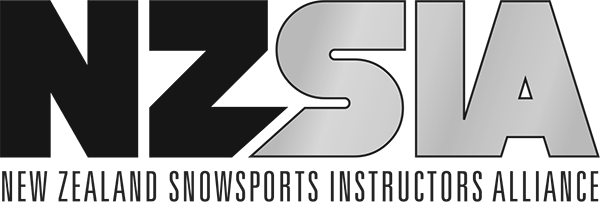I was fortunate to go out on an on-snow clinic with Tony Macri from the USA National Team on the last day at Interski.
Most of you will also know that Tony is an SBINZ Senior Examiner and sits on our own Snowboard Committee. Tony dominates in everything he does, bringing a massive amount of experience and knowledge to the snow sports instructors world.

Maccers doing what he does best
The outcomes of the clinic were to:
- Explore how movements of the body interact with Board Performances to create fundamental relationships of snowboarding.
- Apply these fundamentals in practical teaching progressions to facilitate more in-depth learning.
Firstly we paired up and followed each other observing our partner’s body movements. In the US system they have broken these body movements down to just:
- Flexion and Extension
- Rotation
These body movements achieve the four board performances twist, rotation, tilt, and pressure. The task then determines when, where and how much we need to use flexion, extension, and rotation. We had a lot of fun in groups coming up with a teaching task to emphasis flexion, extension and rotation to apply to the four board performances. The different nations presented the following:
- Twist – flat ground 360s
- Rotation – speed checks
- Tilt – carving grabbing the board indy on toe side and method on heelside
- Pressure – nose press 360
Tony then got us to ride the chair and asked us “How do we measure the body movements in our system?” In the US they use timing, intensity, and duration, which is similar to us. To showcase this, we rode through a required assessment criteria task for Level One, Two and Three candidates on the appropriate terrain.
Level Three – Small skidded retraction closed turns; blending with speeding up the timing of the body movements.
Level Two – Medium down unweight skidded closed turns.
Level One – Large up unweight closed turns; slowing down and being patient with the timing of the body movements.

Maccers demonstrating Level One positioning
In conclusion, Tony wrapped up with highlighting The Learning Connection model; a framework that offers guidance for creating deeper connections between the student and instructor. A great lesson is the instructor’s ability to provide a blend of teaching skills, people skills, and technical skills. Today’s focus on the ‘Fundamentals of Snowboarding’ sat in the technical skills part of this model.

The Learning Connection model
Our Reflections
My golden takeaway from the clinic is to ask yourself as an instructor “how”, then ask “how” again and again until you get to the root of your student’s issue – which will always be to flex, extend or rotate. Tony used an example of a student wanting to do a tail press; “well, how?”. Move your hips towards the tail… “How?” Flex your back ankle and knee.
Tony referenced the theme of Interski Future.Snowsports with clearly outlining that the US system is not trying to reinvent the wheel, but rather “clean up our material” with refining it and keeping it simple for all of the eight divisions across America.

Claire and Maccers getting to hang out in Bulgaria
Next time you’re out instructing try asking yourself “but how” enough times to get to the root of the issue your student is having. Does it always come back to flexion, extension, and rotation body movements for the four board performances? Have fun!
– By Claire Dooney
